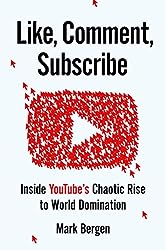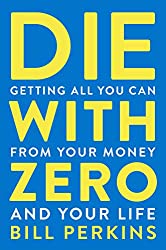
Rating: 8.3/10.
Like, Comment, Subscribe: Inside YouTube’s Chaotic Rise to World Domination by Mark Bergen
Book about the history of YouTube, from its inception to the present day, covering its ups and downs, as well as the controversies it faced. As YouTube exploded in popularity, right now hundreds of hours of videos are uploaded every minute. The book tells the story of how YouTube managed this flood of content through a combination of machine learning algorithms and human intervention, as it built a revenue model.
YouTube was founded in 2005, with the first challenge of synchronizing audio and video since it was built on Flash. It gained traction on the Myspace social media platform, where people quickly started posting videos that gained popularity. From the early days, users uploaded personal clips, TV content, and various random videos. YouTube had to develop policies to deal with issues like porn, gore, and copyrighted material, which included content uploaded both by the original owners and unauthorized users. The platform also saw the emergence of new creative formats that were not viable on mainstream media, giving small creators a new way to reach audiences.
In 2006, Google acquired YouTube after it launched its own video platform but was losing to YouTube. The acquisition made sense as YouTube was growing rapidly and needed more resources to handle the increasing traffic and moderation demands. After the acquisition, YouTube had to figure out its revenue model, opting to handle ads and splitting slightly over half of the revenue with creators rather than paying for content like Netflix.
As YouTube’s popularity grew, it faced thorny issues of moderation and political content, especially messages conflicting with different countries’ views on free speech. This became particularly apparent during the Arab Spring in 2011 when YouTube became not just a place to watch funny videos, but a platform for serious political messages. Moderating such content was challenging to decide where to draw the line and enforce it consistently, because some of this journalism was extremely violent, leading to difficult decisions about what constituted journalism and what content needed to be taken down.
One of the fundamental principles of YouTube was to use algorithms and machine learning for recommendations as much as possible, instead of human intervention. So they had to make an important decision about which metric to optimize, and in 2012 they switched to optimizing for watch time instead of views. This would better reflect the value that viewers obtained from the video, since if views were incentivized, it often led to clickbait content that disappointed viewers. This change caused many creators to see their traffic disappear overnight, which is always a risk present on YouTube, and while some may lose, others become winners. In this case, it allowed “let’s play” videos to become highly popular, as they were long, cost-effective to produce, involved minimal editing. In this genre, the creator talks while playing a video game, and this helped Swedish gamer PewDiePie become one of the biggest YouTubers, mastering the “let’s play” genre of videos.
A difficulty for YouTube was kids videos. A lot of brands like Disney did not have any content on YouTube, so the top of the search results would be content not officially affiliated with Disney and would get millions of views for anybody searching for these characters. Kids were also less discerning about what videos they watch and would get addicted much more easily. This ended up with a lot of very addictive videos of unboxing kids toys, which YouTube thought was not very healthy. Then, in 2017, it got really weird with the Elsagate scandal, which was a lot of videos for kids with nightmarish cartoons and adults making sexually provocative videos with Disney characters, and this got a lot of media attention before YouTube shut it down.
Another type of video that was hard to moderate was on controversial topics, such as conspiracy theorists, which ended up being an echo chamber as well. YouTube would recommend the videos that you would spend the most time watching, resulting in an echo chamber of conspiracy theory videos, and many of the time these videos would appear at the top of the trending page. YouTube’s biggest creator, PewDiePie, got involved with an anti-Semitic controversy that was bordering on the line between satire and hate speech. This caused advertisers to be nervous when the ads would be associated with these videos, and many of the big advertisers pulled funding, which is a significant loss for YouTube’s revenue stream.
In the present day, YouTube primarily depends on algorithmic moderation and recommendation systems due to the sheer volume of content uploaded every minute. The quantity of videos is far too vast for any number of human moderators to manage properly. The current method is a blend of algorithmic processes fine-tuned with human intervention to steer the content in one direction or another. Changes are made to the moderation rules and the algorithm whenever the moderation team deems certain content inappropriate. This system keeps everything under control, leading us to where we are today.
The book concludes on a positive note, especially after YouTube’s growth surged during the COVID-19 pandemic. Many younger generations have grown up watching YouTube, rarely watching traditional TV. Compared to many other social media platforms that have devolved into irrelevance due to content moderation issues, YouTube continues to stand strong, doing a better job than most at managing and moderating content. Currently, it remains one of the best platforms for creators to make money.
Overall, this book tells a comprehensive history of YouTube, from its founding to the present day. It covered many famous YouTubers and controversies that the company had to handle. There was little about technical challenges, which were assumed to be straightforward, focusing more on dealing with the challenges of content and moderation. Many of these controversies were similar, so by the end, it felt slightly repetitive. However, it revealed a pattern in how YouTube manages incidents: issues would escalate until they got the attention of the YouTube team, who would then adjust the algorithm on an ad hoc basis to prevent similar problems, including people re-uploading deleted clips. This approach has resulted in a stable platform that creators, viewers, and advertisers more or less trust.



